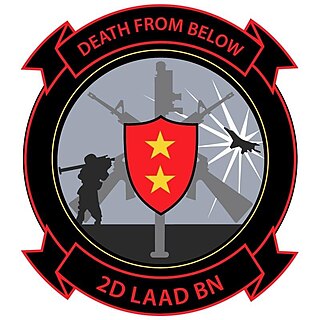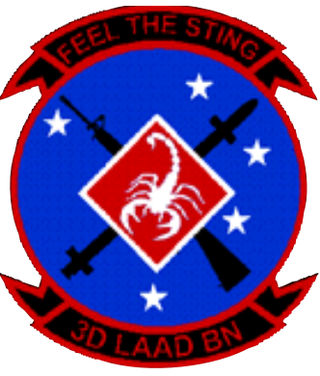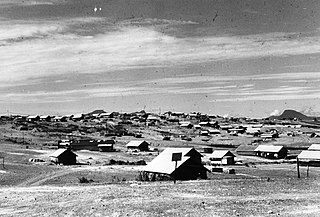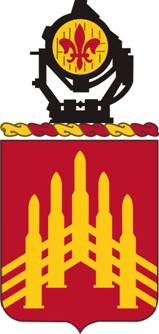
The 9th Infantry Division is an inactive infantry division of the United States Army. It was formed as the 9th Division during World War I, but never deployed overseas. In later years it was an important unit of the U.S. Army during World War II and the Vietnam War. It was also activated as a peacetime readiness unit from 1947 to 1962 at Fort Dix, New Jersey, and Fort Carson, Colorado, and from 1972 to 1991 as an active-duty infantry division at Fort Lewis, Washington. The division was inactivated in December 1991.

The M42 40 mm Self-Propelled Anti-Aircraft Gun, or "Duster," is an American armored light air-defense gun built for the United States Army from 1952 until December 1960, in service until 1988. Production of this vehicle was performed by the tank division of the General Motors Corporation. It used components from the M41 light tank and was constructed of all-welded steel.

2nd Battalion, 11th Marines (2/11) is an artillery battalion comprising four firing batteries and a Headquarters Battery. The battalion is stationed at Marine Corps Base Camp Pendleton, California. Its primary weapon system is the M777 lightweight howitzer. The battalion was the first in the Marine Corps to fully transition from the M198 Howitzer. They fall under the command of the 11th Marine Regiment and the 1st Marine Division.

Robert Earl Cleary was a United States Marine who served as the 10th Sergeant Major of the Marine Corps from 1983 to 1987. He served in the Marine Corps for 36 years, including seeing combat in both the Korean War and the Vietnam War. For his actions in Vietnam, he was awarded the Silver Star, the Navy Commendation Medal, and two Purple Hearts. He was the last Sergeant Major of the Marine Corps to have served in the Korean War.

Marine Air Control Group 28 (MACG-28) is a United States Marine Corps aviation command and control unit based at Marine Corps Air Station Cherry Point that is currently composed of four command and control squadrons and a low altitude air defense battalion that provide the 2nd Marine Aircraft Wing with airspace coordination, air control, immediate air support, fires integration, air traffic control (ATC), radar surveillance, aviation combat element (ACE) communications support, and an integrated ACE command post in support of the II Marine Expeditionary Force.

Marine Air Control Group 18 (MACG-18) is a United States Marine Corps aviation command and control unit based at Marine Corps Air Station Futenma that is currently composed of 4 squadrons and 1 HQ support detachment. The Marine Air Control Group as a whole provides the 1st Marine Aircraft Wings tactical headquarters, positive and procedural control, air traffic control, short range air defense and air defense control to aircraft for the III Marine Expeditionary Force.

Marine Air Control Squadron 4 (MACS-4) is a United States Marine Corps aviation command and control squadron that provides aerial surveillance, Ground-controlled interception, and air traffic control for the III Marine Expeditionary Force. Originally formed in World War II, the squadron's most notable combat operations occurred during the Vietnam War when it was the first unit to ever use the Marine Tactical Data System. They are currently based at Marine Corps Air Station Futenma and fall under the command of Marine Air Control Group 18 and the 1st Marine Aircraft Wing.

The 2d Low Altitude Air Defense Battalion is an air defense unit of the United States Marine Corps. The battalion is subordinate to Marine Air Control Group 28 (MACG-28) and the 2nd Marine Aircraft Wing and is currently based at Marine Corps Air Station Cherry Point. The battalion is composed of one Headquarters and Support Battery and two Firing Batteries.

The 3d Low Altitude Air Defense Battalion is an air defense unit of the United States Marine Corps currently responsible for providing short range air defense. The battalion falls under the command of Marine Air Control Group 38 (MACG-38) and the 3rd Marine Aircraft Wing and is currently based at Marine Corps Base Camp Pendleton, California.

Hill 55 is a hill 16 kilometres (9.9 mi) southwest of Da Nang, Quảng Nam Province, Vietnam. The hill is located 3 kilometres (1.9 mi) northeast of the confluence of the Yen, Ai Nghia, and La Tho Rivers and was a United States Marine Corps base during the Vietnam War.

The 2nd Air Defense Artillery Regiment is an air defense artillery regiment of the United States Army, first formed in 1821 as a field artillery unit.

The 71st Air Defense Artillery was a regiment in the United States Army.

Monkey Mountain Facility was a U.S. Air Force (USAF) and Marine base located on Sơn Trà Mountain east of Da Nang.
Hill 327 is a former U.S. Marine Corps (USMC), U.S. Army and Army of the Republic of Vietnam (ARVN) base southwest of Da Nang in central Vietnam. The base was established on a ridgeline 4 km west of Da Nang Air Base.

1st Light Antiaircraft Missile Battalion was a United States Marine Corps air defense unit equipped with the medium range surface-to-air MIM-23 HAWK Missile System. The battalion was the lineal descendant of the 1st Defense Battalion which gained fame during World War II for its defense of Wake Island early in the war. 1st LAAM also deployed to Vietnam in 1965 providing air defense for the Marine Corps in the I Corps sector. The battalion was last based at Marine Corps Air Station Yuma, Arizona and fell under the command of Marine Air Control Group 38 (MACG-38) and the 3rd Marine Aircraft Wing.

2nd Light Antiaircraft Missile Battalion was a United States Marine Corps air defense unit equipped with the medium range surface-to-air MIM-23 HAWK Missile System. 2nd LAAM was based at Chu Lai during the Vietnam War and was responsible for providing air defense for the Marine Corps in the northern part of the I Corps sector. After Vietnam, the battalion was based at Marine Corps Air Station Yuma, Arizona and fell under the command of Marine Air Control Group 38 (MACG-38) and the 3rd Marine Aircraft Wing. 2nd LAAM Battalion's last combat tour saw it providing air defense for the Marine Corps area of operations during Operation Desert Shield/Desert Storm. 2nd LAAM Battalion was deactivated on 1 September 1994 as part of the post-Cold War draw down of forces and because the Marine Corps had made the decision to divest itself of its medium-range air defense. The battalions personnel and equipment were transferred to 1st Light Antiaircraft Missile Battalion.

3rd Littoral Anti-Air Battalion is a United States Marine Corps aviation command and control and air defense unit that is optimized for operations in the first island chain. The battalion is based at Marine Corps Base Hawaii and falls under the command of the 3rd Marine Littoral Regiment and the 3rd Marine Division.

The History of ground based air defense in the United States Marine Corps dates back to the early 1930s with the establishment of the Advanced Base Force. World War II would be the high-water mark for air defense units when 20+ defense/anti-aircraft battalions were formed with many seeing significant action throughout the Pacific Theater. Following the war, the Marine Corps divested itself of most of its air defense capability at a time when the service was facing deep personnel cuts and fighting for its institutional survival. Beginning in the early 1950s the Marine Corps aligned itself with the Navy and their development of surface-to-air missiles (SAMs). The Marine Corps retained both flak weapons and SAMs throughout the 1950s until the fielding of the MIM-23 Hawk Missile System in 1960. The HAWK Missile was employed by Light Antiaircraft Missile (LAAM) battalions and remained a mainstay of Marine Corps ground based air defense for the next four decades.
Marine Air Traffic Control Units (MATCU) were United States Marine Corps air traffic control (ATC) detachments that provided continuous, all-weather, radar and non-radar, approach, departure, enroute, and tower ATC services at both garrison Marine Corps Air Stations and tactical airfields when deployed. MATCUs possessed Tactical air navigation systems (TACAN) and Ground-controlled approach (GCA) equipment which assisted Marine Corps, joint and coalition aircraft in conducting landings during inclement weather. During the Vietnam War, numerous MATCUs served throughout the I Corps Tactical region of South Vietnam supporting the III Marine Amphibious Force. Beginning in the mid-1970s, the Marine Corps decided to consolidate regionally aligned MATCUs into Marine Air Traffic Control Squadrons. The last reserve MATCU was decommissioned in 1980.


















